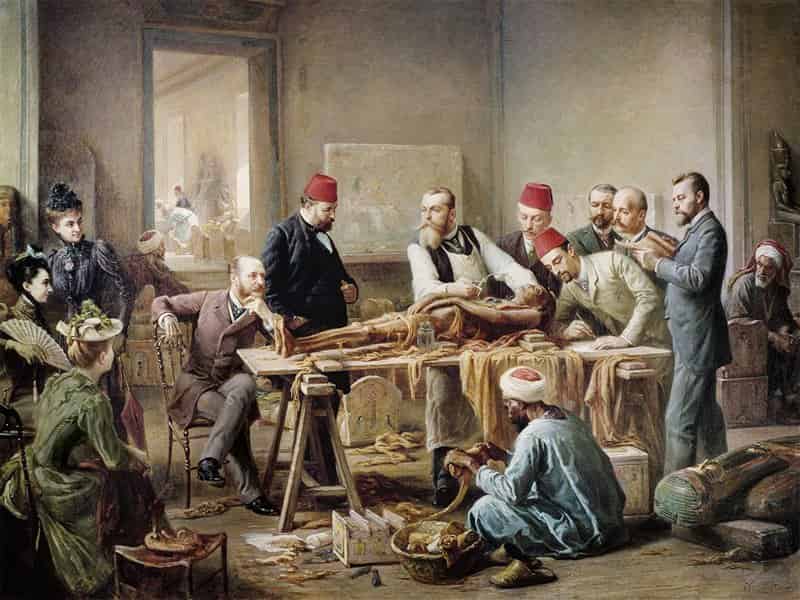In 1902, when a group of scientists was examining the famous Pharaoh’s mummy in the recently opened Egyptian Museum in Tahrir Square, Cairo, an event took place that shocked those gathered there—even novelists of the stature of Pierre Loti or Vicente Blasco Ibáñez, whose descriptions of the event can be found in their collected works.
After its discovery in the Deir el-Bahari cache of 1870, the mummy of Ramses II, along with many of his pharaonic companions, was transferred to Cairo and housed in the Boulaq Museum (predecessor of the current Egyptian Museum in Cairo) to be studied by the world’s leading experts of the time.
In 1886, the mummy of Ramses the Great was studied by the country’s highest archaeological authority, Gaston Maspero, Director General of the Egyptian Antiquities Service, who, in front of many authorities, confirmed the identity of the Pharaoh thanks to an inscription on the shroud.
From Boulaq to Tahrir Square
However, in addition to removing the bandages from the mummy, Maspero also revealed three inscriptions engraved on the coffin. The first explained how the mummy was restored in Herihor’s time (1106-1077 BC), while the other two described the transfer of the great Pharaoh’s mummy, first from its original location to the tomb of his father, Seti I, and then to the tomb of Queen Ahmose-Inhapy, from the 17th dynasty (around 1540 BC).
The mummy of Ramses II, which was in pretty good condition, was finally housed in a special room and protected under a glass cover.
In 1902, the current headquarters of the Egyptian Museum in Cairo was inaugurated in Tahrir Square, a large building designed by the French architect Marcel Dourgnon.
The royal mummies, including Ramses II, were arranged on the first floor of the building, but they were not available for public viewing.
In fact, the royal mummies could only be seen by illustrious visitors and in very exceptional cases. These visitors included the prestigious novelists Pierre Loti and Vicente Blasco Ibáñez.
Ramses is moving!
At that time, talk of mummies’ magic and possible curses was quite popular, and novels starring evil mummies who came back to life were beginning to be successful among readers.
Loti, who was accompanied by Director Gaston Maspero when he visited the Museum in 1907, was struck by a story he heard about an event that happened shortly after the Museum’s inauguration. Blasco Ibáñez echoed his account.
In his work, Around the World of a Novelist, Loti reports the following:
“The truth is that the mummy of Ramses II, without losing his reclining immobility, raised one of his hands, slapping the glass cover.… All the guardians of the Egyptian museum, who had looked with some alarm at the arrival of the terrible character, not losing sight of him for a moment in his new installation, they immediately realized his awakening.… They ran terrified towards the doors, fighting for who would escape first.”
A Logical Explanation
But did Ramses II really raise his left arm? Well, it seems that yes, but the explanation for such an event is quite simple: the pharaoh’s mummy was not at that time in a controlled environment and a sudden change in temperature caused the tendons of the arm to contract spontaneously.
Blasco Ibáñez himself explains it in his book: “[The mummy’s joints] suffered the dilation produced by heat on certain materials, one of them moving spasmodically [from his arms]”.
In fact, one day, British scientist Sir Grafton Elliot Smith was studying and photographing the mummy of Ramses II.
When his aide began to remove the bandages covering the pharaoh’s arm, the long-compressed fibers of the limb suddenly contracted, and the scientists standing next to the mummy retreated when they saw that the great pharaoh moved an arm seeming to awaken from his millennial dream, making a gesture that seemed to be an order.
Obviously nothing supernatural happened and the mummy of the pharaoh did not intend to indicate anything.
But if it had been possible, what would Ramses II have said to those gathered there? We will never know.
First photo: Study of a mummy in the Egyptian Museum in Cairo.
Source: Carme Mayans, national geographic






